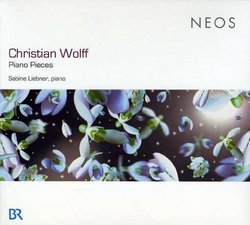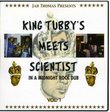| All Artists: Christian Wolff, Sabine Liebner Title: Christian Wolff: Piano Pieces Members Wishing: 1 Total Copies: 0 Label: Neos Original Release Date: 1/1/2008 Re-Release Date: 5/27/2008 Album Type: Import Genre: Classical Styles: Chamber Music, Historical Periods, Classical (c.1770-1830) Number of Discs: 1 SwapaCD Credits: 1 UPCs: 675754007867, 4260063107238 |
Search - Christian Wolff, Sabine Liebner :: Christian Wolff: Piano Pieces
 | Christian Wolff, Sabine Liebner Christian Wolff: Piano Pieces Genre: Classical
|
Larger Image |
CD DetailsSimilar CDs |
CD ReviewsTreacherous music scarecrow | Chicago, Illinois United States | 06/29/2009 (5 out of 5 stars) "The piano's timbre has circled round Wolff's entire existence,much like a bird of prey hovering,It was a timbre he continualy returned to.
However the consumption process is never completed,For Wolff has kept performative freedoms as an integral part of his music,allowing the pianist in on the creative act by ommitting articulations, expression marks, sometimes tempi,dynamics. Such performative freedoms was brought with a unique voice to the Cage cadre of creators,(circa 1950-1970) largely sometimes arbitrarily now lumped together as a School with Morton Feldman, Earle Brown, John Cage. Christian Wolff found a voice with politics,something the others of this group ran shunned like a poison waiting to envelope their very beings; they did all share in similar identical opportunities for venues,even trading commissions when one proved too busy to fulfill it, as Cage allowing a commission with the Toyko Philharmonic of Wolff's "Etudes for Orchestra". Yet budding stories abide that in the formative years, the(Fifties) only John Cage knew how to get things done in planning a concert event, press and critics, audience,rehearsal lights and performance;when things didn't go right, pieces were sometimes re-worked,re-written, like an ensemble piece that became, becomes a piano solo; But each here went separate ways at some point finding audiences quite separately,developing different paradigms for themselves;All it seemed got away from the vigours of experimentalisms, as graphic notation, as Earle Brown, finding a more predictable "managed" style of working with fixed yet unfixed music events,and ensembles, moments; Feldman as well kept his unique safely lyrical style finding new paradigms in long durational minimalisms,quite different in content to the more corruptible forms of repetitive patternings music marketing to death. Christian Wolff found new roads with political history, icons and imagery, as a newly found content to "unabstract",make more concrete the language within the avant-garde as it had developed prior; This interest roughly began around 1971-72 with his "Changing the System" for mixed(any number) ensemble; with text recited; a holdover from the 1968 Years of Anti-War demonstrations;also his "Accompaniments"(after text of Mao) was quite effective for a pianist who recites texts; this followed by more impressive things as, the thorny,convoluted,virtuosic "preludes"(1980). These now used old Wobbly Songs from American labour history; embedded into "abstract" arrays of linearities;the incessantly chordal#12 "Acres of Clams","Rock Candy Mountain,"Halelulah I'm a Bum";Then in quick succession more piano solo music,Wolff tapped a rich vein here' then a tune "for the disappeared"; quite severely focused;"Peace March" and more ensemble pieces to labour icons Harriet Tubman,Emma Goldman,Ruth Crawford Seeger and composer Hanns Eisler; These "Piano Pieces" we see the more reflective, introspective Wolff, actually I found little difference herein with the more committed consciously political piano music;both seem cut from the same emotive cloth simply no iconic imagery is provided here to guide the dramatic invention of the music. The pieces here are dedicated to pianist John Tilbury,(also has a recording some on Matchless). Tilbury who has long been fascinated with Wolff's relatively laid-back gentle music,as Tilbury's equal interest in the complete oeuvre of Feldman; knowing both composer's music as far back as the early Sixties where he had premiered it in England and at festivals in Eastern Europe. Back then Britain exhibited a blandly conservative culture that hardly had use for the post-war avant-garde, vaulting over the serial scientific moments of this music; The Cage cadre brought a breath of fresh air in England from the coldly abstracted calculations found in the now establishment composers,upper tier composers as Boulez and Stockhausen,Oddly but the Cage cadre here appealed to the more social working class dimensions within British culture with their now accessible experimentalisms,largely never really experienced on the Queen's Island, elements always in the forefront of cognition of how culture is perceive and consumed; These pieces #s,1,2,4,5 are dedicated to Tilbury, as well as separate pieces simply entitled "Tilbury 1, and #2;(one can utilize electronics if desired). These are private sounding pieces,strangely beautiful; with some rhythmic high energy,much like his "preludes" they have a non-functional linearity,often sounding arbitrary; like frozen objects on a canvas of timbre, not really compelled to go forward, except where Wolff deploys fast,furious rhythms as #6 here;or motives returning,filigrees, and patterns#6 is in fact dedicated to piano composer Howard Skempton. The pianist must bring much to these pieces as the "preludes", to charge them,with some possessed incendiary forms emotionally impacted helps as well; In fact you may quite often find uninspired readings of Wolff's music by quite capable players; Here Sabine Liebner has the ticket and does all the right interpretive things, briging an expressitivity to all the materials; And curious how the quiet,private timeless moments have nothing to do with how Feldman may have equally exploited this emotive strain, the hanging,non-pulsed(it seems) tones, barely audible single tones, thrown elegantly in all registers of the piano; Wolff's single tones seem ever more less bleak, more controlled, not introducing too many tones in quick succession as is the compositional trap;Some however for contrast as #7 has a predictable tempo, almost 120 to the quaver, quarter note;and as #9,Wolff maintains interest on the registral canvas by focused places, usually single basso tones, quite unassuming, quite simple,yey not resembling a tune,simply a linear array;thensimply thrown in the same place as a Twombly canvas; with higher register tones,(not going anywhere) quite stark against each other, modernity at work still resides in the paradigms exploited in this music;" |

 Track Listings (20) - Disc #1
Track Listings (20) - Disc #1
